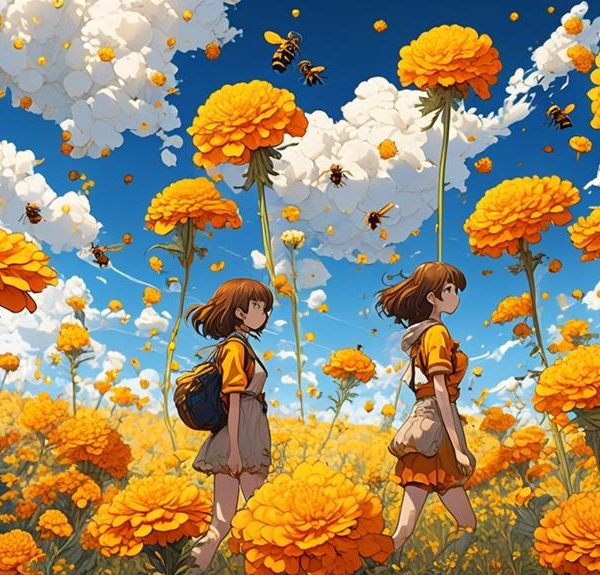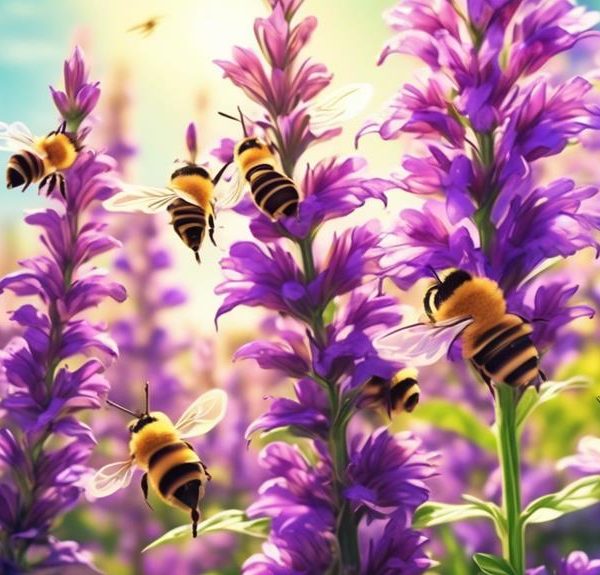Swarming around agapanthus, do bees find these flowers irresistible? Discover the intricate relationships within our ecosystem.

Do Bees Like Agapanthus?
In the same way a knight would be drawn to his fair damsel, you might wonder if bees are similarly attracted to agapanthus. You've seen these majestic flowers in bloom, their globes of blue or white blossoms standing tall in many a garden, but have you ever stopped to observe if our buzzing friends show any preference for them?
This question isn't just about satisfying your curiosity, it's about understanding intricate relationships within our ecosystem. So, let's dive into this mystery, shall we? Can the answer ultimately help us make better choices for our gardens and the environment?
Key Takeaways
- Agapanthus flowers, with their vibrant blue or white blooms, act as a magnet for bees.
- Agapanthus provides bees with high nectar production and abundant pollen, attracting various species of bees.
- Bees play a significant role in the propagation and survival of Agapanthus by transferring pollen, resulting in cross-pollination and genetic diversity.
- The symbiotic relationship between Agapanthus and bees enhances garden biodiversity and can bolster local bee populations.
Understanding the Agapanthus Plant

While you may be drawn to the striking blue blossoms of the Agapanthus plant, it's essential to delve into the characteristics that make this plant a potential favorite for bees.
Native to South Africa, Agapanthus plants, also known as Lily of the Nile, are characterized by their long, slender green leaves and intense purple-blue flowers that bloom in the summer months.
These perennials require full sun or partial shade and well-drained soil to thrive, making them a popular choice for garden borders and containers. But it's not just their aesthetic appeal that's noteworthy; these plants are an excellent source of nectar, attracting pollinators such as bees and butterflies.
The presence of a high nectar concentration in the tubular flowers of the Agapanthus provides bees with the energy they need to continue their pollination activities. Additionally, the distinctive color of its flowers, predominantly blue, is particularly attractive to bees, as they perceive this color more vividly than others.
Understanding these traits of the Agapanthus plant allows you to appreciate not only its beauty but also its eco-friendly role in our environment. By planting Agapanthus, you're providing bees with a valuable food source while adding a splash of color to your garden.
How Bees Interact With Flowers
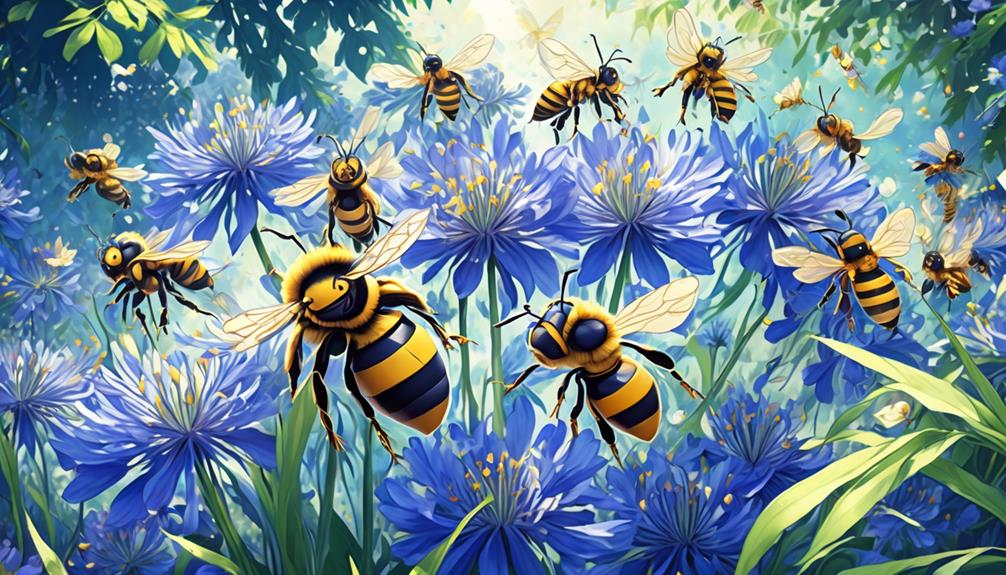
Building on the relationship between bees and Agapanthus plants, let's explore the fascinating process of how bees interact with flowers in general. As a bee lands on a flower, it's collecting nectar and pollen for its hive. The bee's body is designed for this task. With their long tongues, they can reach into the deepest parts of the flower to extract the sweet nectar.
As you interact with your garden, you may notice bees buzzing around flowers with a purpose. They're not just there for the nectar; they're essential for pollination. As bees move from flower to flower, they transfer pollen, aiding in the fertilization process of plants. This symbiotic relationship benefits both the bees and the flowers.
To illustrate, let's delve into a simple table:
Bee Role | Flower Benefit |
|---|---|
Pollen Collection | Fertilization |
Nectar Extraction | Pollination |
Visit Variety of Flowers | Genetic Diversity |
Hive Sustenance | Seed Production |
Propagation | Growth & Survival |
Agapanthus and Bee Attraction

In your garden, you'll often find that Agapanthus, with its vibrant blue or white blooms, acts as a powerful magnet for bees, drawing them in with its rich nectar and abundant pollen. The botanical relationship is a symbiotic one. In return for the sustenance, bees inadvertently act as pollinators, spreading the plant's genetic material and ensuring its survival.
Agapanthus flowers, native to South Africa, are known for their high nectar production, which is essential for bees. It's the sugar content in this nectar that provides energy for bees' flight and honey production. Moreover, the pollen grains found in Agapanthus are rich in proteins, vital for bee growth and development.
But it isn't just the bees benefitting. The plant's vibrant colors and unique ultraviolet patterns, visible only to insects, are strategic signals, ensuring bees' attraction. Additionally, the Agapanthus' bell-shaped flowers provide an easy landing platform for bees, facilitating nectar extraction.
Observations From Beekeepers
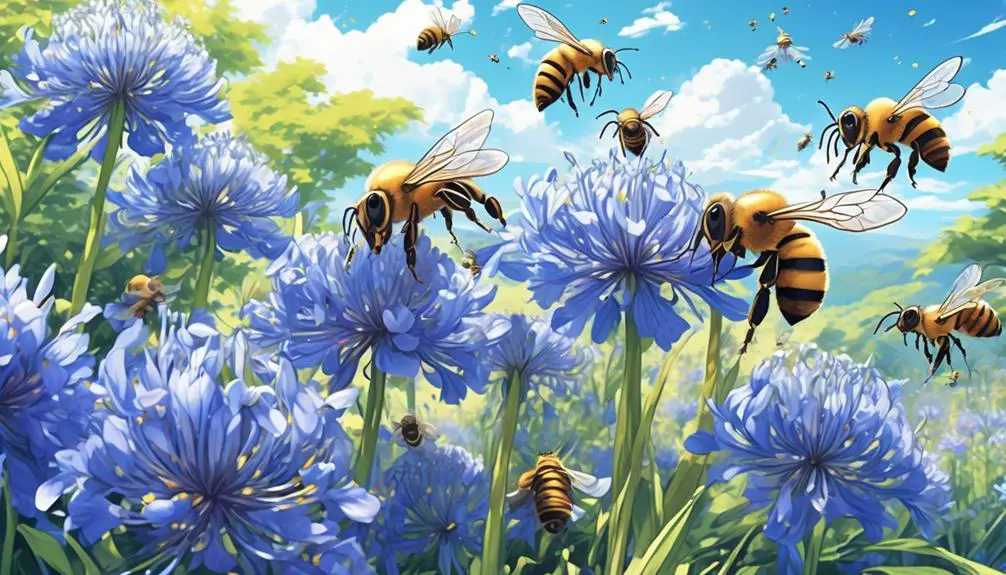
Beekeepers, with their hands-on experience and keen observations, can attest to the allure Agapanthus holds for bees. They've witnessed bees of various species congregating around these plants, attracted by their vibrant colours and the sweet nectar they offer.
As a beekeeper, you may observe this interaction closely. You'll notice that the bees not only hover around the Agapanthus but they also dive deep into the flower trumpets to access the nectar. This activity is not random but purposeful, as the bees are instinctively drawn to these plants.
To give you a clearer picture of beekeepers' observations, here's a table detailing their findings:
Bee Species | Agapanthus Variety | Observation |
|---|---|---|
Honey Bees | Agapanthus africanus | Bees frequently visit and forage for nectar |
Bumble Bees | Agapanthus orientalis | Bees appear attracted to the bright colours |
Carpenter Bees | Agapanthus praecox | Bees often seen burrowing into the flower trumpets |
These observations underscore the Agapanthus' attractiveness to bees. Remember, your role in facilitating this interaction is fundamental. By cultivating Agapanthus in your garden, you're not only enhancing its aesthetic appeal but also promoting a thriving bee population.
Impact on Garden Ecosystems
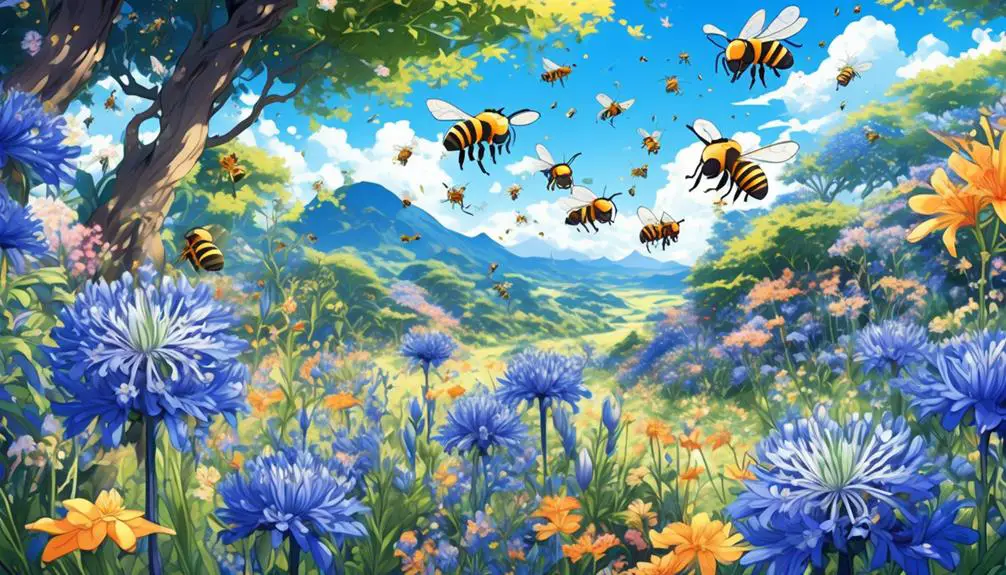
While you're observing bees' affinity for Agapanthus, it's also crucial to understand the profound impact this relationship has on your garden's ecosystem. Bees, being key pollinators, play a significant role in the propagation and survival of the Agapanthus plant. When a bee visits an Agapanthus flower for its nectar, pollen grains stick to the bee's body. As it flies to another flower, some of these grains are transferred, resulting in cross-pollination. This process is vital for the genetic diversity and health of Agapanthus populations.
In turn, the Agapanthus provides bees with a reliable source of nectar during the summer months when other flowers may not be in bloom. This symbiotic relationship enhances the biodiversity of your garden, attracting other beneficial insects and pollinators.
Moreover, the vibrant, blue Agapanthus flowers aren't just visually appealing; they're also excellent at attracting bees. This means that a garden filled with Agapanthus can be a haven for bees, bolstering local populations.
Frequently Asked Questions
How Does the Climate Affect the Relationship Between Bees and Agapanthus?
Climate significantly impacts your bees' interaction with agapanthus. In warmer climates, agapanthus blooms earlier, providing nectar when bees are highly active. However, in cooler climates, blooms may coincide with decreased bee activity.
You'll notice that bees' attraction to agapanthus flowers heavily depends on the availability of other nectar sources too. So, temperature, bloom time, and competition for resources altogether shape the relationship between bees and agapanthus.
What Other Insects Are Attracted to the Agapanthus Plant?
You're not just going to find bees buzzing around agapanthus. This plant's bright, beautiful blooms also attract a variety of other insects.
Butterflies, for example, are drawn to its nectar. Hoverflies and ladybugs also frequent agapanthus.
However, it's not all good news. Agapanthus has a reputation for attracting snails and slugs, which can damage the plant. So, while it's a hit with many insects, it's also a magnet for pests.
How Does Agapanthus Compare to Other Flowers in Terms of Attracting Bees?
Comparing agapanthus to other flowers in terms of attracting bees, you'll find it's a top contender. Agapanthus blooms are rich in nectar, which bees can't resist. They're also vividly colored, visible from a distance, and have a shape that's easy for bees to access.
While other flowers also attract bees, agapanthus' unique combination of features makes it a particularly favorite for these pollinators. So, it's fair to say agapanthus holds its own in the bee-attracting game.
What Is the Nutritional Value of Agapanthus Nectar to Bees?
You're wondering about the nutritional value of Agapanthus nectar to bees.
It's actually quite beneficial. This nectar is rich in sugars, primarily fructose and glucose, providing energy for bees.
It also contains trace amounts of amino acids, vitamins, and minerals, which contribute to bees' overall health.
However, it's worth noting that the exact nutritional content can vary depending on environmental factors.
Can the Agapanthus Plant Be Harmful to Bees in Any Way?
No, agapanthus plants aren't harmful to bees. In fact, they're quite beneficial. These plants offer a rich source of nectar, which bees use as food. They're also pollen-rich, supporting bee reproduction.
However, ensure the plants aren't treated with harmful pesticides, as these can be detrimental to bees.
Conclusion
So, do bees fancy agapanthus?
Absolutely! These plants, with their vibrant, nectar-rich blossoms, are hotspots for bees. Beekeepers have observed their bees flocking to agapanthus, and it's not hard to see why.
Besides offering a food source, agapanthus helps foster a diverse garden ecosystem.
So, planting these beauties in your garden isn't just a win for the bees, it's a win for your entire garden's biodiversity.

